Malware analysis - part 2: My NASM tutorial.
﷽
Hello, cybersecurity enthusiasts and white hackers!
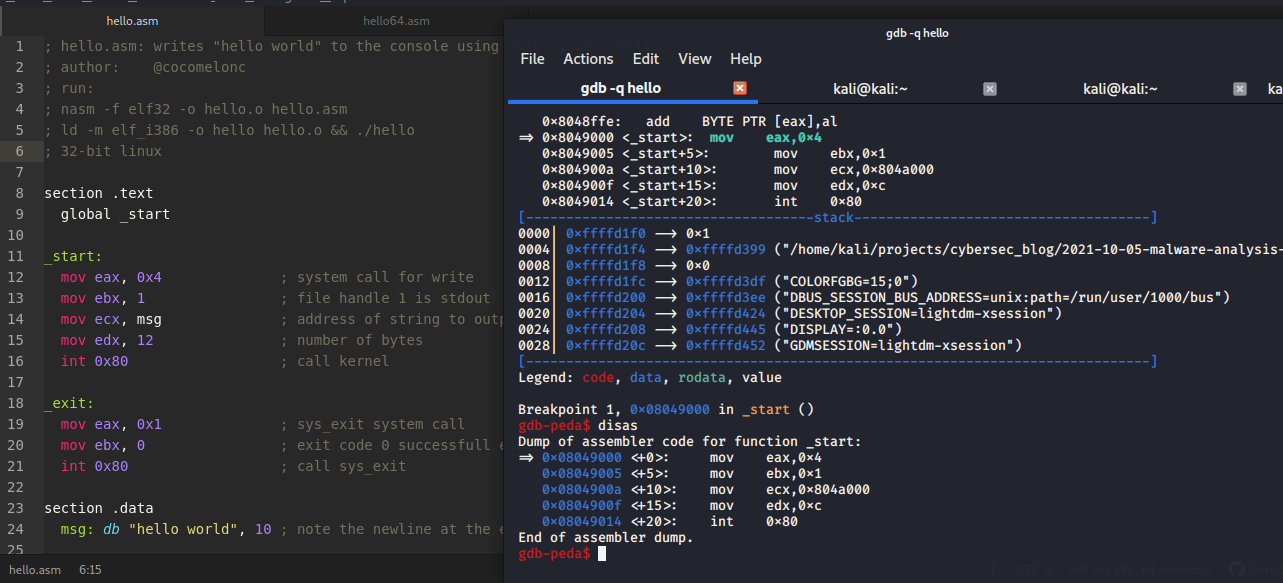
NASM tutorial
So, I am continuing a series of articles dedicated to my journey in the study of malware analysis.
In the last post in the series, I started learning examples in assembly language.
This tutorial will show you how to write assembly language programs on the x86 architecture, but now I will also provide code examples that integrate with C language.
Once again, make sure we have both nasm and gcc installed:
nasm --version
gcc --version
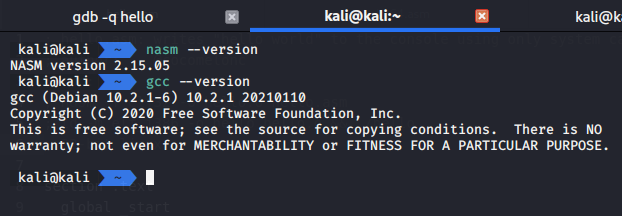
Let’s go to repeat some instructions:
mov a, b ; copy b to a
and a, b ; copy "a logical AND b" to a
or a, b ; copy "a logical OR b" to a
xor a, b ; copy "a logical XOR b" to a
add a, b ; copy a + b to a
sub a, b ; copy a - b to a
inc a ; increment a (copy a + 1 to a)
dec a ; decrement a (copy a - 1 to a)
db ; pseudo-instruction that declares bytes
; will be in memory when the program runs
As i wrote earlier, in fact, most of the basic instructions have only the following forms:
mov eax, ebx ; copy register to register
mov ebx, [123] ; copy memory address to register
mov [123], eax ; copy register to memory address
mov eax, 0x12 ; copy immediate to register
mov [151], 0x55 ; copy immediate to memory address
Pseudo-instructions are things which, though not real x86 machine instructions, are used in the instruction field anyway because that’s the most convenient place to put them:
db 0x55 ; just the byte 0x55
db 0x55,0x56,0x57 ; three bytes in succession
db 'a',0x55 ; character constants are OK
db 'hello',13,10,'$' ; so are string constants
dw 0x1234 ; 0x34 0x12
dw 'a' ; 0x61 0x00 (it's just a number)
dw 'ab' ; 0x61 0x62 (character constant)
dw 'abc' ; 0x61 0x62 0x63 0x00 (string)
dd 0x12345678 ; 0x78 0x56 0x34 0x12
dd 1.234567e20 ; floating-point constant
dq 0x123456789abcdef0 ; eight byte constant
dq 1.234567e20 ; double-precision float
dt 1.234567e20 ; extended-precision float
To reserve space (without initializing), you can use the following pseudo instructions. They should go in a section called .bss (you’ll get an error if you try to use them in a .text section):
buffer: resb 64 ; reserve 64 bytes
wordvar: resw 1 ; reserve a word
realarray: resq 10 ; array of ten reals
hello world
So what about our first practical example? Let’s start with the classic “Hello world” program:
; hello.asm: writes "hello world" to the console.
; author: @cocomelonc
; run:
; nasm -f elf32 -o hello.o hello.asm
; ld -m elf_i386 -o hello hello.o && ./hello
; 32-bit linux
section .text
global _start
_start:
mov eax, 0x4 ; system call for write
mov ebx, 1 ; file handle 1 is stdout
mov ecx, msg ; address of string to output
mov edx, 12 ; number of bytes
int 0x80 ; call kernel
_exit:
mov eax, 0x1 ; sys_exit system call
mov ebx, 0 ; exit code 0 successfull exec
int 0x80 ; call sys_exit
section .data
msg: db "hello world", 10 ; note the newline at the end
Compile and run:
nasm -f elf32 -o hello.o hello.asm
ld -m elf_i386 -o hello hello.o
./hello
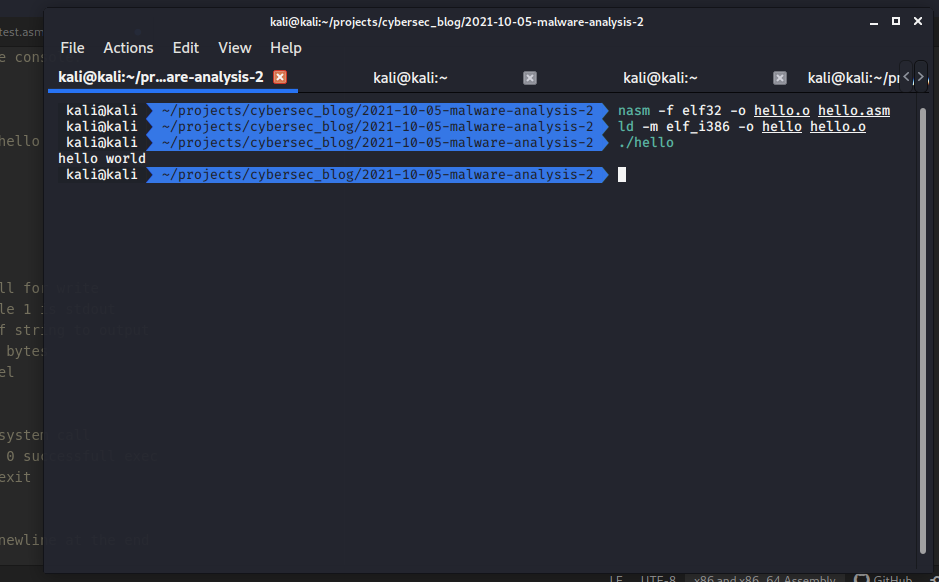
As you can see everything work as expected. Our program writes “hello world” to the console using only system calls. Let’s examine lines 12-16:

Everything is written in the comments to my code:
line 12: system call for write.
line 13: file descriptor (stdout).
line 14: message “hello world”.
line 15: number of bytes.
line 16: system interrupt call.
As for lines 19-21:

they are identical to the logic from an example from first post, it’s just normal exit logic.
I hope you haven’t forgotten about the instruction int 0x80. There is an int 0x80 instruction in the assembler code. This is a system interrupt. When the processor receives interrupt 0x80, it performs the requested system call in kernel mode, while getting the desired handler from the Interrupt Descriptor Table.
hello world via using C library
Let’s go to code our “hello world” example with using C library. Remember how in C execution “starts” at the function main? That’s because the C library actually has the _start label inside itself! The code at _start does some initialization, then it calls main, then it does some clean up, then it issues the system call for exit. So you just have to implement main. We can do that in assembly!
; hello.asm: writes "hello world" to the console by using C lib.
; author: @cocomelonc
; run:
; nasm -f elf32 -o hello2.o hello2.asm
; gcc -static -m32 -o hello2 hello2.o && ./hello2
; 32-bit linux
section .text
global main
extern puts
main: ; called by C lib startup code
push msg ; address of string to output
call puts ; puts (msg)
add esp, 4 ; update stack pointer (1 argument 4 byte)
xor eax, eax ; a faster way of setting eax to zero
ret ; return from main back into C library wrapper
msg: db "hello world", 0 ; note strings must be terminated with 0 in C
which is equivalent in C:
#include <stdio.h>
int main(void) {
puts ("hello world");
return 0;
}
I think from the comments to the code everything should be clear, this is a simplest example:
on line 14, a call to the puts() function: call puts. Before this call, the address of the string (or a pointer to it) with our “hello world” is pushed onto the stack using the push instruction. After the puts() function returns control to the main() function, the address of the string (or a pointer to it) is still on the stack. Since it is no longer needed, the stack pointer (esp register) is updated. add esp, 4 means add 4 to the value in the ESP register. Why 4? Because this is 32 bit code. After calling puts(), the original C code states return 0 - return 0 as the result of the main() function. In the generated code, this is provided by the instruction: xor eax, eax
Let’s go to compile and run:
nasm -f elf32 -o hello2.o hello2.asm
gcc -static -m32 -o hello2 hello2.o
./hello2

As you can see again everything is good.
Let’s go to load this binary to gdb and debug:
gdb -q hello2
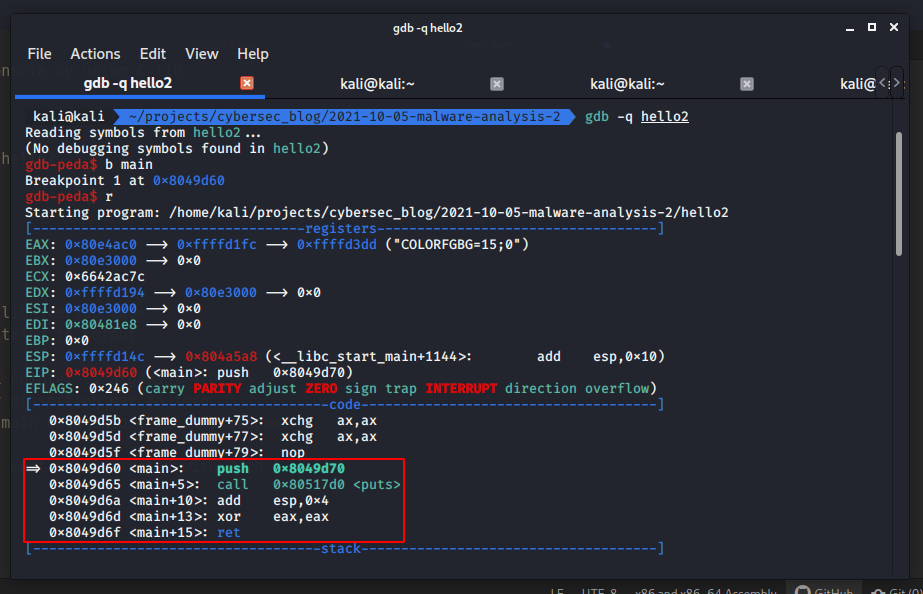
Let’s now cross-compile the C code:
#include <stdio.h>
int main(void) {
puts ("hello world");
return 0;
}
to an .exe file:
i686-w64-mingw32-gcc hello.c -o hello2.exe
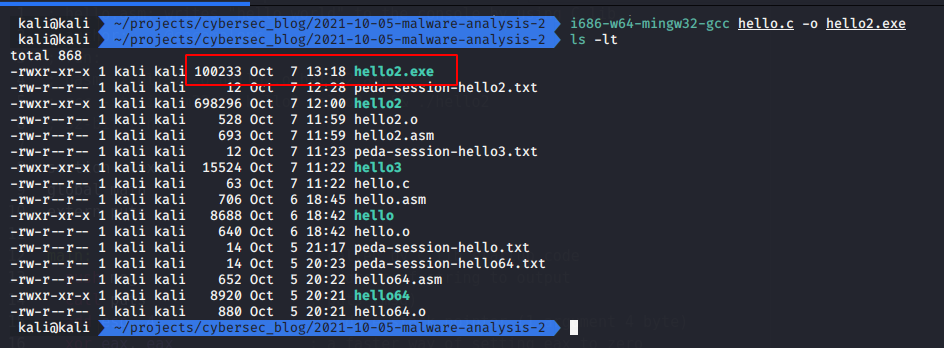
Basic static analysis
Since I consider all my examples from the point of view of a malware analyst, let’s do a little static analysis of our three files:
hello - compilation result of hello.asm:
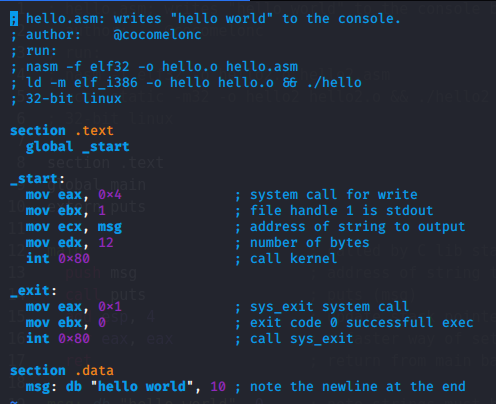
hello2 - compilation result of hello2.asm:
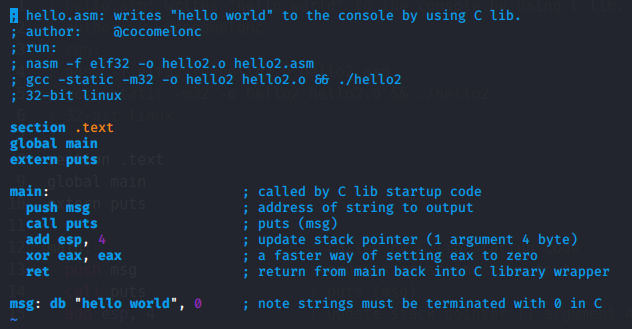
and hello2.exe - cross-compilation result of hello.c:

Firstly, run:
file hello
file hello2
file hello2.exe
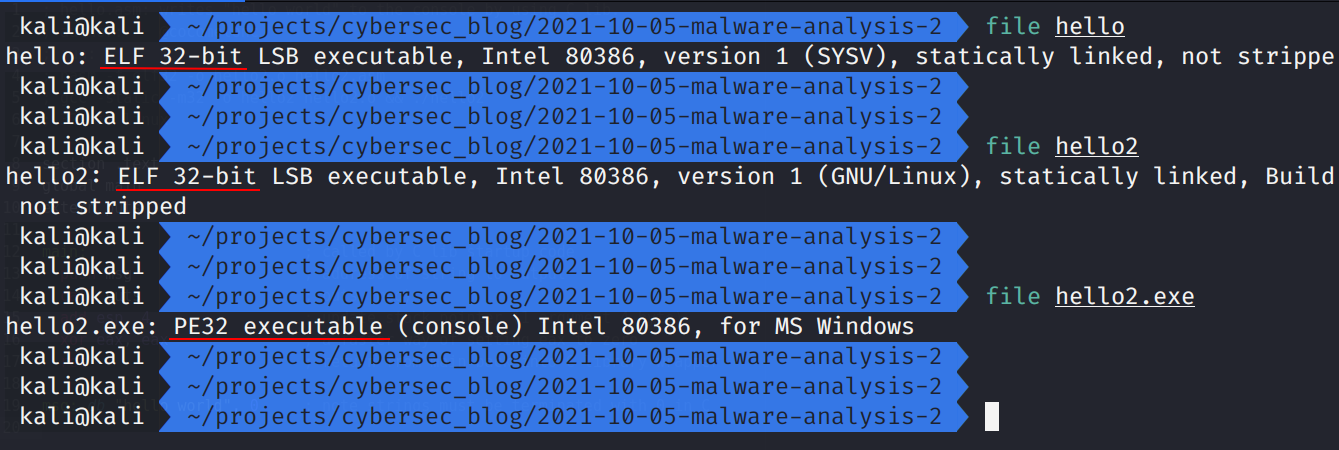
Then, run:
hexdump -C hello | head 20
hexdump -C hello2 | head 20
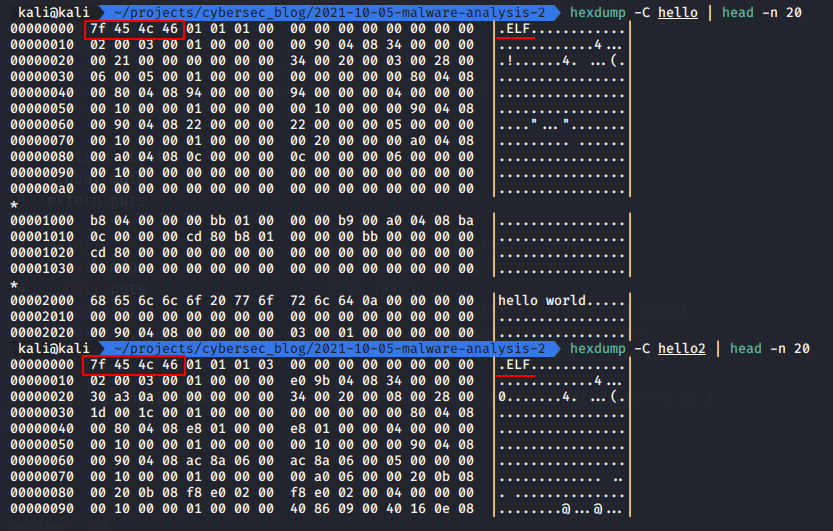
I hope you haven’t forgotten that hello and hello2 are ELF (Executable and Linkable Format) files. What we see here?
As can be seen in this screenshot, the ELF header starts with some magic. This ELF header magic provides information about the file. The first 4 hexadecimal parts define that this is an ELF file (45=E,4c=L,46=F), prefixed with the 7f value.
This ELF header is mandatory. It ensures that data is correctly interpreted during linking or execution. To better understand the inner working of an ELF file, it is useful to know this header information is used.
Let’s see an hello2.exe:
hexdump -C hello2.exe | head 20

All the valid PE files contain the value of the first two-byte as 4D and 5A (“MZ” in ASCII), named after Mark Zbikowsky, a well-known architect of MS-DOS. Under this header, includes a list of structure.
Also all the valid PE files contain “PE” (Portable Executable).
Then, run:
strings -n 6 hello | head
strings -n 6 hello2 | head
strings -n 6 hello2.exe | head
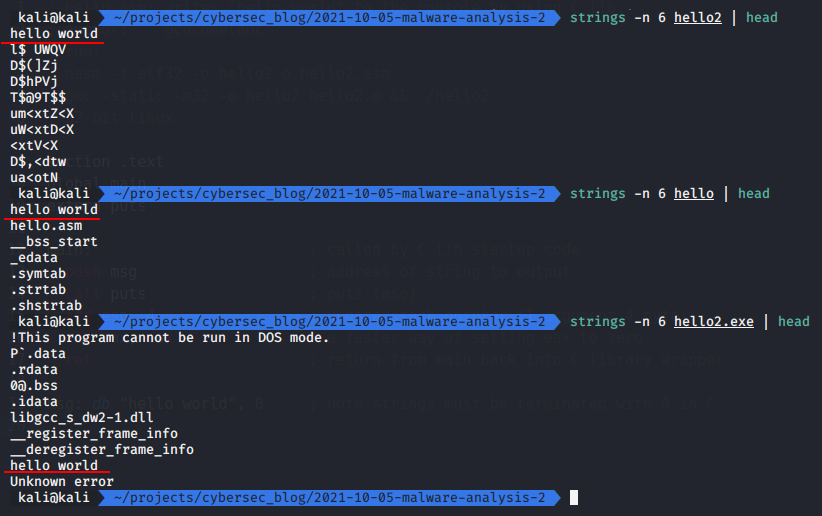
As you can see all three files contain “hello world” string.
And then run:
objdump -D -M intel hello | head
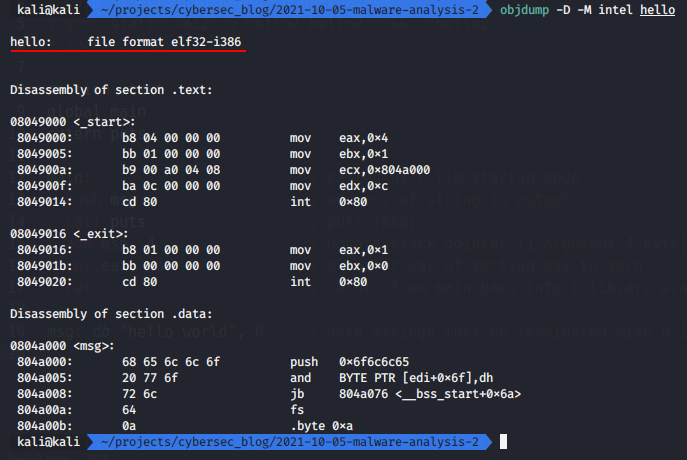
then run:
objdump -D -M intel hello2 | head

and for exe file, run:
objdump -D -M intel hello2.exe | head

As you can see in this way you can also understand the file type by its headers.
If you run:
objdump -D -M intel hello2.exe | grep main.: -A11

I want to draw your attention to these instructions that I indicated in the screenshot. These 2 instructions save the previous base pointer ebp and set EBP to point at that position on the stack (right below the return address). This sets up EBP as a frame pointer.
Some compilers may subtract the required space from the stack pointer after this two instructions, then write each argument directly, see below:
push ebp
mov ebp, esp
sub esp, 12 ; if 3 arguments (4*3 bytes)
These 3 lines are known as the assembly function prologue. Now let’s look at an example and you will immediately understand what does it mean. Let’s consider this C code:
#include <stdlib.h>
int main(void) {
return 123;
}
This code in assembler will look like this:
; example1.asm
; author: @cocomelonc
; run:
; nasm -f elf32 -o example1.o example1.asm
; gcc -static -m32 -o example1 example1.o
; 32-bit linux
section .text
global main
main:
push ebp
mov ebp, esp
mov eax, 123
mov esp, ebp
pop ebp
ret
section .data
Let’s check. Firstly, compile, then run objdump:
nasm -felf32 -o example1.o example1.asm
gcc -static -m32 -o example1 example1.o
objdump -D -M intel example1 | grep main.: -A11

I want to draw your attention to these instructions that I indicated in the screenshot. This is called the assembly function epilogue. The function epilogue invalidates the allocated stack space, restores the EBP value to the old one, and returns control to the calling function.
If you compile and disassembly C code:
i686-w64-mingw32-gcc example1.c -o example1.exe
objdump -D -M intel example1.exe | grep main.: -A11
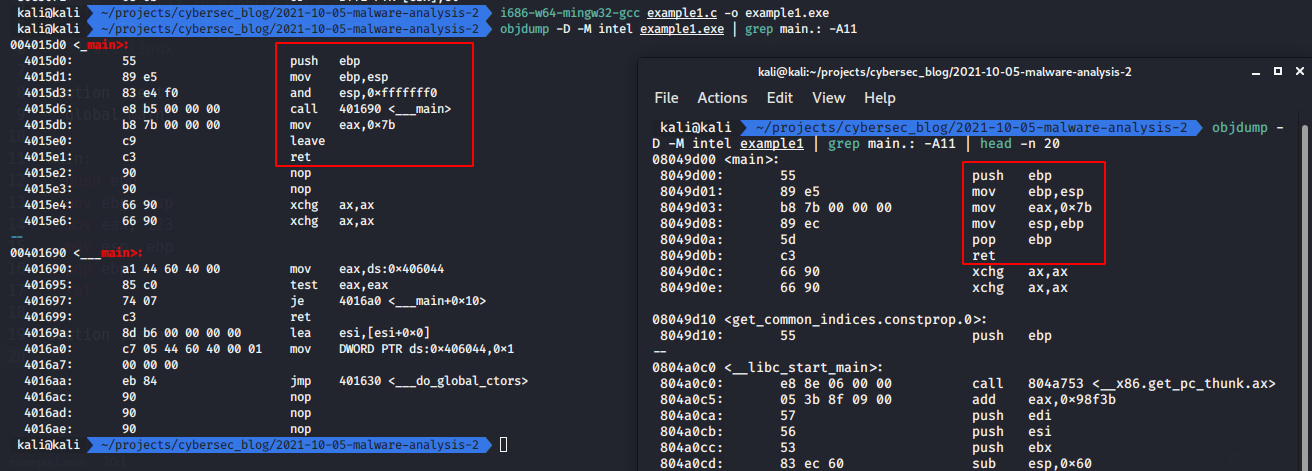
Stop! But we see leave instruction. The leave instruction does exactly what these two instructions do, and is used by some compilers to save code size. (enter 0,0 is very slow and never used; leave is about as efficient as mov + pop.)
Prologue and epilogue are usually found in disassemblers to separate functions from each other.
memory addressing modes
Let’s go to examine another example:
#include <stdlib.h>
int addMe(int a, int b) {
return a + b;
}
int main(void) {
addMe(2, 3);
return 0;
}
Let’s see how it’ll be look on x86 assembly language:
; example2.asm
; author: @cocomelonc
; run:
; nasm -f elf32 -o example2.o example2.asm
; gcc -static -m32 -o example2 example2.o
; 32-bit linux
section .text
global main
; make new call frame (addMe)
addMe:
push ebp ; save old call frame
mov ebp, esp ; initialize new call frame
mov eax, 0 ; move 0 to eax
mov edx, [ebp + 8] ; move second arg to edx
mov eax, [ebp + 12] ; move first arg to eax
add eax, edx ; add to result
pop ebp ; restore call frame
ret ; return (to main)
; make new call frame (main)
main:
push ebp ; save old call frame
mov ebp, esp ; initialize new call frame
push 3 ; push call arguments in reverse
push 2 ; push 2
call addMe ; call function addMe
xor eax, eax ; mov eax, 0
; restore old call frame
; some compilers may produce a 'leave' instruction instead
mov esp, ebp
pop ebp ; restore old call frame
ret
section .data
Let’s go to compile and run objdump:
nasm -f elf32 -o example2.o example2.asm
gcc -static -m32 -o example2 example2.o
objdump -D -M intel example2 | grep main.: -A11 | head -n 20
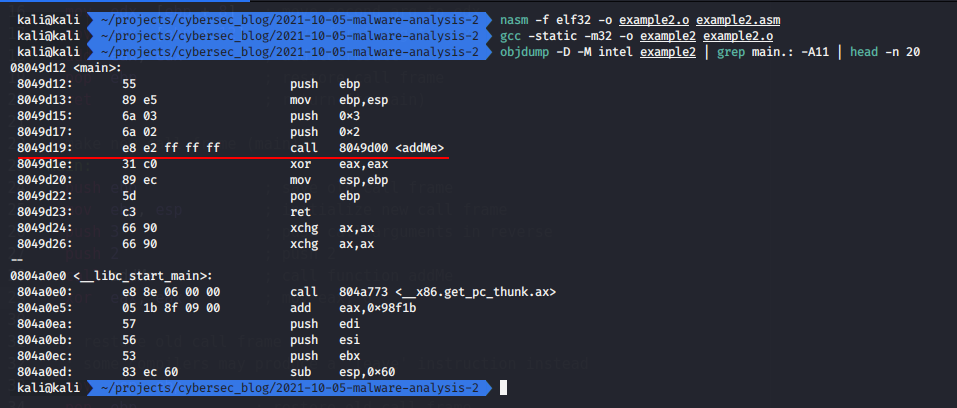
and if we run:
objdump -D -M intel example2 | grep addMe.: -A11 | head -n 20

as you can see after insructions:
push 3
push 2
we go to function addMe in address 08049d00.
Let’s go to debug with gdb:
gdb -q ./example2
gdb-peda$ b main
gdb-peda$ r

next steps:
gdb-peda$ si
gdb-peda$ disas

as you can see, push arguments, and we are in function main now.
Then next steps:
gdb-peda$ si
gdb-peda$ disas
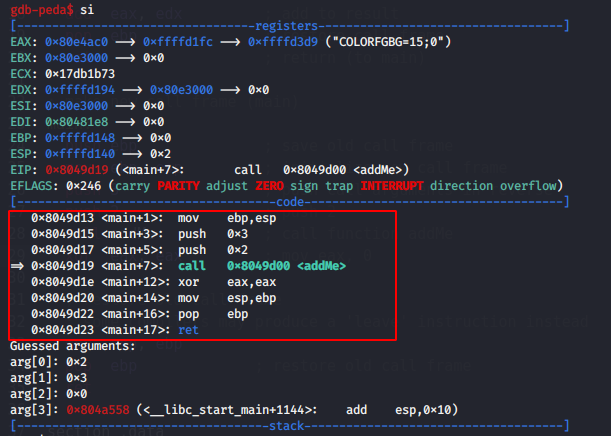
and repeat once again:

and we are call subroutine addMe. And a few more steps:

we are push arguments and add to result (eax).
The x86-32 instruction set supports using up to four separate components to specify a memory operand. The four components are a fixed displacement value, a base register, an index register, and a scale factor. An effective address is calculated as follows:
effective address = base register + index register * scale factor + displacement
The base register can be any general-purpose register; the index register can be any general-purpose register except ESP; Displacement values are constant offsets that are encoded within the instruction; valid scale factors include 1,2,4, and 8. The size of the final effective address is always 32 bits.
For example:
mov eax, [MyVal] ; displacement
mov eax, [ebx] ; base register
mov eax, [ebx + 12] ; base register + displacement
mov eax, [MyArray + esi * 4] ; displacement + index register * scale factor
mov eax, [ebx + esi] ; base register + index register
mov eax, [ebx + esi + 12] ; base register + index register + displacement
mov eax, [ebx + esi * 4] ; base register + index register * scale factor
mov eax, [ebx + esi * 4 + 20] ; base register + index register * scale factor + displacement
In our case we push call arguments, in reverse:
mov edx, [ebp + 8]
mov eax, [ebp + 12]
add eax, edx
If your function has 3 arguments, in reverse:
mov edx, [ebp + 8] ; move third arg to edx
add eax, edx ; add to result
mov edx, [ebp + 12] ; move second arg to eax
add eax, edx ; add to result
mov edx, [ebp + 16] ; move first arg
add eax, edx ; add to result
If your function has 4 arguments, add:
mov edx, [ebp + 20] ; first arg
add eax, edx ; add to result
; ...
etc… I think your got the main idea.
As I wrote earlier, some compilers may subtract the required space from the stack pointer, something like this:
sub esp, 16 ; 16 bytes (4 arguments * 4 bytes)
mov edx, [ebp + 8]
add eax, edx
mov edx, [ebp + 12]
add eax, edx
mov edx, [ebp + 16]
add eax, edx
mov edx, [ebp + 20]
add eax, edx
add esp, 16 ; remove call arguments from frame (16 bytes)
Continue to examine our debug. And a few more steps:

we are return to function main(void):
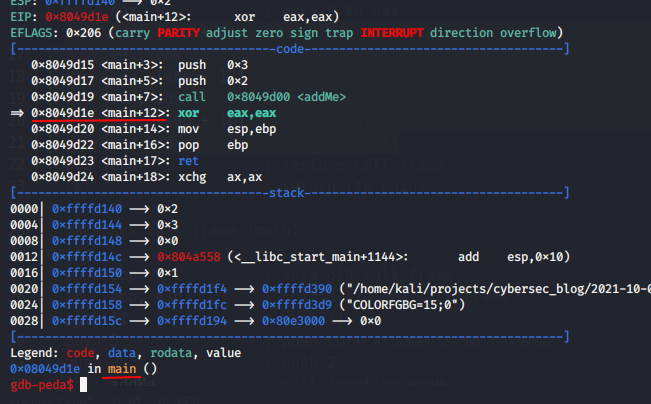
I think now you understand better why we needed to understand stacks. Suppose we have a function f1 that calls function f2, and function f2, in turn, calls function f3. When the function f1 is called, it is assigned a certain place on the stack for local data. This space is allocated by subtracting from the ESP register a value equal to the size of the required memory. The minimum size of the allocated memory is 4 bytes, i.e. even if the procedure needs 1 byte, it should take 4 bytes.
The f1 function does some things and then calls the f2 function. The f2 function also makes space on the stack by subtracting some value from the ESP register. In this case, the local data of the functions f1 and f2 are located in different memory areas. Next, the function f2 calls the function f3, which also allocates space for itself on the stack. The f3 function does not call any other functions and at the end of its work it must free up space on the stack by adding to the ESP register the value that was subtracted when the function was called. If the function f3 does not restore the value of the ESP register, then the function f2, continuing to work, will not access its data, since it looks for them based on the value of the ESP register. Similarly, the function f2 must restore the value of the ESP register upon exiting, which was before its call.
Thus, at the level of procedures, it is necessary to follow the rules for working with the stack - the procedure that took up space on the stack last must free it first. If this rule is not followed, the program will not work correctly. But each procedure can access its own stack area in an arbitrary way. If we were forced to follow the rules for working with the stack inside each procedure, we would have to transfer data from the stack to another memory area, and this would be extremely inconvenient and would extremely slow down the program execution.
Each program has a data area where global variables are located. Why is local data stored on the stack? This is done to reduce the amount of memory occupied by the program. If the program calls several procedures sequentially, then at each moment of time space will be allocated only for the data of one procedure, since the stack is occupied and released. The data area exists all the time the program is running. If local data were located in the data area, it would be necessary to allocate space for local data for all program procedures.
Let’s update our function addMe:
#include <stdlib.h>
int addMe(int a, int b) {
return 42 * a + b;
}
int main(void) {
int c;
c = addMe(3, 5);
return 0;
}
which is equivalent this x86 assembly code:
; example2.asm
; author: @cocomelonc
; run:
; nasm -f elf32 -o example3.o example3.asm
; gcc -static -m32 -o example3 example3.o
; 32-bit linux
section .text
global main
; make new call frame (addMe)
addMe:
push ebp ; save old call frame
mov ebp, esp ; initialize new call frame
mov eax, [ebp + 8] ; move a to eax
imul edx, eax, 42 ; calculate result
mov eax, [ebp + 12] ; move second arg to eax
add eax, edx ; add to result
pop ebp ; restore call frame
ret ; return (to main)
; make new call frame (main)
main:
push ebp ; save old call frame
mov ebp, esp ; initialize new call frame
push 3 ; push call arguments in reverse
push 2 ; push 2
call addMe ; call function addMe
mov [ebp + 8], eax ; move result to c
xor eax, eax ; mov eax, 0
; restore old call frame
; some compilers may produce a 'leave' instruction instead
mov esp, ebp
pop ebp ; restore old call frame
ret
section .data
let’s go to compile and analyze:
nasm -f elf32 -o example3.o example3.asm
gcc -static -m32 -o example3 example3.o
objdump -D -M intel example3 | grep main.: -A11 | head -n 11
objdump -D -M intel example3 | grep addMe.: -A11 | head -n 10
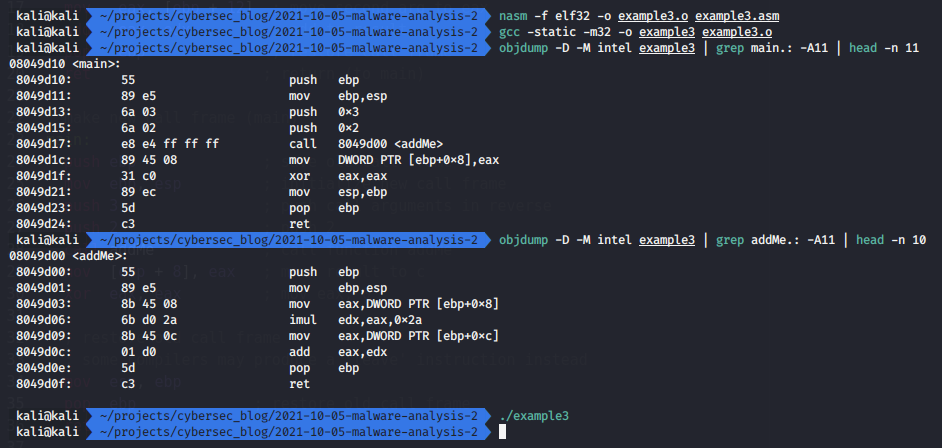
As you already understood, the imul instruction is used for multiplication.
win32 programming
Ok. Everything is good. But since most malware written for windows, the malware analyst often encounters win32 applications when analyzing.
So, let’s go to code win32 example (let’s call it hello3.asm):
; hello3.asm: pop-up "hello world" to the window by using win32 API.
; author: @cocomelonc
; run:
; nasm -f win32 -o hello3.o hello3.asm
; i686-w64-mingw32-ld -o hello3.exe hello3.o -lkernel32 -luser32
; 32-bit windows
[BITS 32]
section .text
global _start
extern _MessageBoxA@16
extern _ExitProcess@4
_start:
; MessageBoxA(HWND hWnd, LPCSTR lpText, LPCSTR lpCaption, UINT uType);
push dword 0 ; push arguments reverse: 0
push caption ; push arguments reverse: caption
push msg ; push arguments reverse: msg
push dword 0 ; push arguments reverse: hWnd
call _MessageBoxA@16 ; call MessageBoxA
; ExitProcess(0)
push dword 0 ; push arguments: 0
call _ExitProcess@4 ; call ExitProcess
section .data:
msg: db "hello world", 0
caption: db "hello", 0
This application is simplest, just pop-up message box with hello world. Let’s examine this code. It uses only plain Win32 system calls from kernel32.dll, so it is very instructive to study since it does not make use of a C library. Because system calls from kernel32.dll are used, you need to link with an import library. You also have to specify the starting address yourself.
Firstly, we have
extern _MessageBoxA@16
extern _ExitProcess@4
This is external Win32 API functions. The number after @ is the number of bytes that the function pops from the stack before the function returns. This should be the number of PUSH instructions before the call multiplied by 4. In most cases, this will also be the number of arguments passed to the function multiplied by 4.
Then we push arguments (reverse order) to MessageBoxA, call it, then push arguments (also reverse order) to ExitProcess and call it.
Let’s go to compile:
nasm -f win32 -o hello3.o hello3.asm
i686-w64-mingw32-ld -o hello3.exe hello3.o -lkernel32 -luser32

and run:
.\hello3.exe
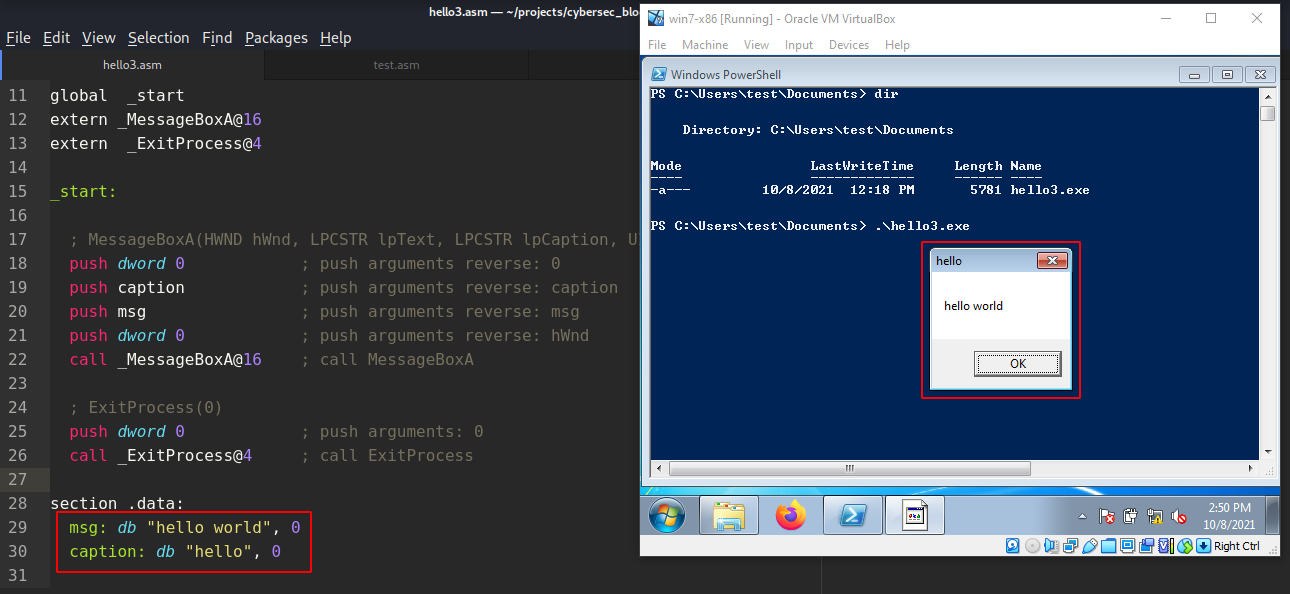
If we go to do some static analysis:
strings -n 6 hello3.exe | head

hexdump -D hello3.exe | head -n 64
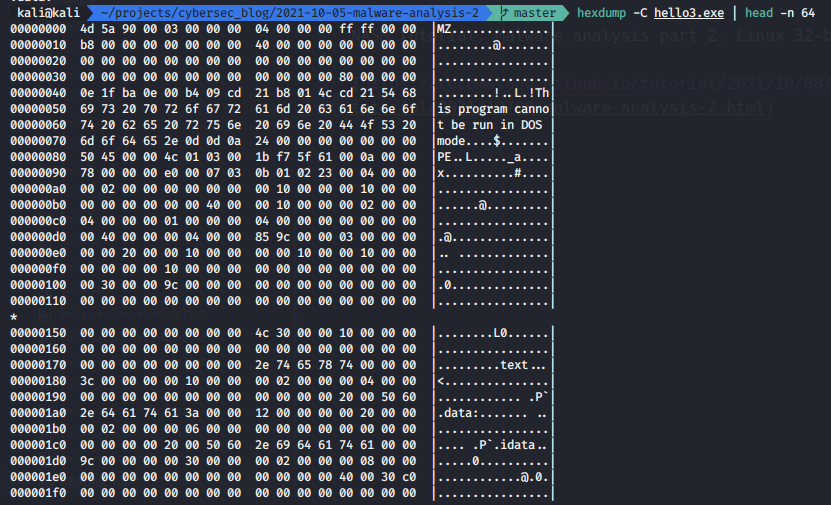
and then:
objdump -D -M intel hello3.exe | head -n 32
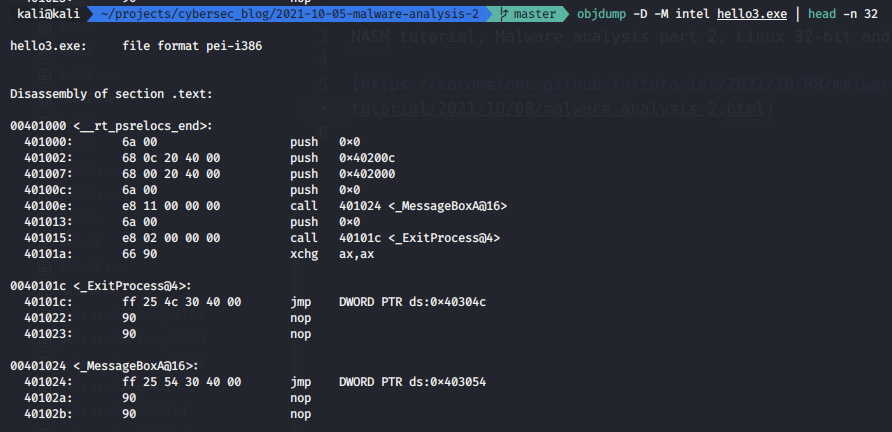
Sometimes, in order to understand what a particular function does, you don’t have to disassemble it, but just look at its inputs and outputs. This way you can save time. But at the same time you still have to look inside.
I will write about this in the next post and I will try to consider real examples of simple malware.
I will write malware in C/C++ like in this, this or this post and then analyze it.
I hope this post was useful for entry level malware analysts or red team members like me, who want to develop skills in the art of reverse engineering.
Reverse engineering for beginners
CS5138 free course materials
Practical Malware Analysis Book
GDB
pefile
intel 64 and IA-32 arch software developer’s manual
Source code in Github
Thanks for your time and good bye!
PS. All drawings and screenshots are mine




